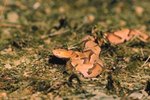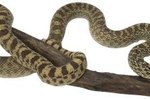
Texas toads (Anaxyrus speciosus) don't have the freedom to just get up and move anywhere, unlike animals with more diverse habitat requirements. The rotund amphibians have a lot of specific needs, whether they pertain to favorite soil types or humidity. Texas toads are prevalent both in the United States and in northern portions of Mexico. As far as states go, they're widespread not only in Texas, but also in New Mexico and Oklahoma.
Texas Toad Basics
These sizable and sturdy nocturnal amphibians possess coarse skin that is adorned in lots of warts, in classic toad fashion. Their upper bodies are generally brown, grayish green, brownish gray, gray or deep yellowish green mixed with elements of either gray or brown. Their lower bodies, in contrast, are usually off-white or white, sometimes with specks. Texas toads frequently feature greenish blotting on the upper portions of their bodies, specifically over their backs. They typically grow to mature lengths of between roughly 2 and 3.5 inches. Texas toads are near kin to great plains toads (Anaxyrus cognatus).
Living Environment
Texas toads' preferred living environments include grassy plains with lots of mesquite plants, grasslands, agricultural sites, pastures and prairies. They favor dirt that has a sandy and loose texture, as they are adept at burrowing. When the weather is hot out, they cope by going underground and staying low-key for a few months at a time. They sometimes even take up residence in burrows that were established previously by gophers. Some opt for sanctuaries in areas just below stones, too. In terms of breeding locales, Texas toads tend to gravitate toward both creeks and narrow channels.
Humidity is Vital
Texas toads have indeed adjusted well to arid climates, although it's still imperative for them to always be able to retreat to areas that have increased levels of moisture in the air. If they can't find places with lots of humidity, it's important for them to be able to at least get to dirt that's damp. Without sufficient water, inordinate drying -- or desiccation -- inevitably becomes a major hazard for Texas toads.
Food Requirements
Texas toads are opportunistic about their eating. If they can access something, they often just eat it. Insects are typical food staples for these amphibians, specifically ants and beetles. They also feed on lots of different arthropods. As nocturnal animals, they eat in the nighttime. Texas toads are particularly enthusiastic about eating right after rainfall.
Predators and Burrowing
Fleeing into burrows is how Texas toads generally respond to threats from predators. Major predators for Texas toads of all ages are garter snakes (genus Thamnophis). Tadpoles of the species are big targets of certain turtles and birds, too.
References
- Standard-Times: This Toad is Totally Texas
- The IUCN Red List of Threatened Species: Anaxyrus Speciosus
- Texas Amphibians: A Field Guide; Bob L. Tipton et al.
- The Frogs and Toads of North America; Lang Elliott et al.
- Amphibian Declines; Michael J. Lannoo
- Frogs and Toads of Big Bend National Park; Gage H. Dayton and Raymond Skiles
Photo Credits
-
Stockbyte/Stockbyte/Getty Images



